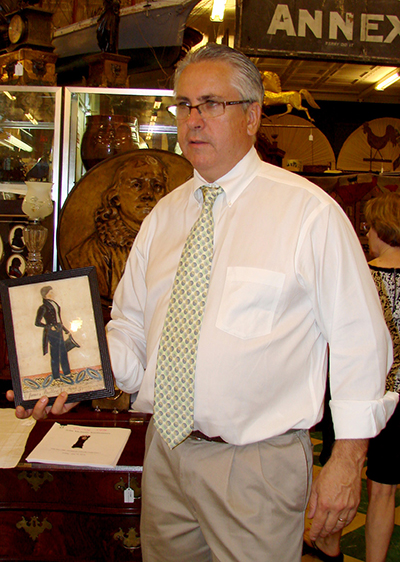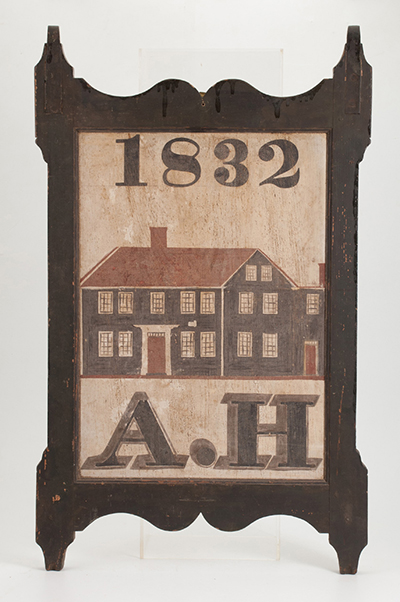
Lot 1 was the A.H. Hill Tavern sign, dated 1832. The double-sided sign, estimated to bring $5,000, finished at $48,380.
Review and Onsite Photos by Rick Russack;
Additional Photos Courtesy John McInnis Auctioneers
AMESBURY, MASS. – Some auctioneers place the expected lead item of the day in the middle of the sale. Not this time. Lot No. 1 in John McInnis’s sale of the William Johnson collection was a tavern sign dated 1832. Hotly contested, it was estimated to bring about $5,000, but ended up selling for $48,380 to a phone bidder who was in partnership with a buyer in the room.
Kelly Kinzle, a New Oxford, Penn., antiques dealer, is one of the owners. He told Antiques and The Arts Weekly that the sign needs some minor conservation work, which will be done soon. Kinzle said that the sign will not be at the New Hampshire Antiques Dealers’ Association show, which he will be doing for the first time. Instead, the sign will probably be held until the Winter Antiques Show in January. Bill Johnson’s widow, who was at the auction, was asked if she had any more information about the sign but she said that she did not.
McInnis sold more than 1,000 lots in the two-day auction, July 10-11, in his gallery. Johnson was a voracious collector, and the sale included numerous advertising signs, clocks, mocha, toys and mechanical banks, folk art, stereo views and other photographica, pocket watches, redware, paintings, fire-related items and much more. The salesroom was filled to capacity, several phone lines were in use and Internet bidding was offered on four platforms. McInnis kept the sale moving and took time, here and there, to cajole bidders he knew to “just try it once more.”
Lunch is on the house at a McInnis auction and free snacks were available throughout the day. After the sale, McInnis said that he was very pleased. “We had a good crowd in the room and everyone seemed to be enjoying themselves. We try to make our auctions a fun place where people can catch up with friends and get some good stuff. I always hear that you won’t get a crowd when Internet bidding is available, but we proved that wrong. I don’t think it could have gone any better.”
An onsite sale was scheduled in Kennebunk, Maine, for July 24-25 to sell more of the collection, along with the real estate.
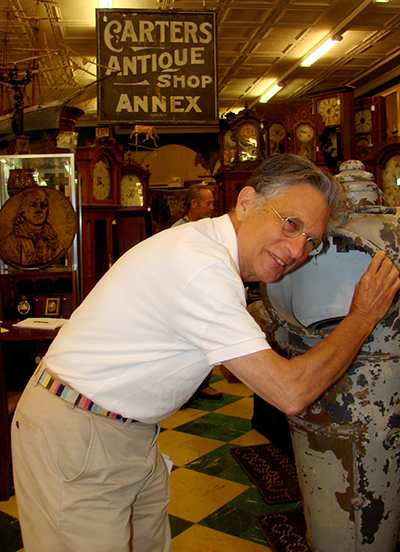
Boston dealer Stephen Score mugs for the camera at the exhibition. He was examining several items, including this ship’s binnacle.
Johnson had been collecting for more than 40 years. He used to run auctions but apparently was more a collector than dealer. His definition of “collectible” included old buildings with local history, and he had hoped to open a museum of his property, utilizing the old buildings, including a one-room schoolhouse, a cabin, a railroad station etc. He died at the age of 73 in 2014. As his widow, Jo, told Antiques and The Arts Weekly, “He died with his boots on.” He was attending an evening auction and others in the audience thought he had fallen asleep, as he was known to sometimes do. But this time he was not sleeping. He is buried on his property.
Jo Johnson also said that she was not interested in antiques when she and Bill met in the 1970s. “He had an apartment on Beacon Hill [in Boston] and there was so much stuff in it that you couldn’t see the walls. Then I began to get interested.”
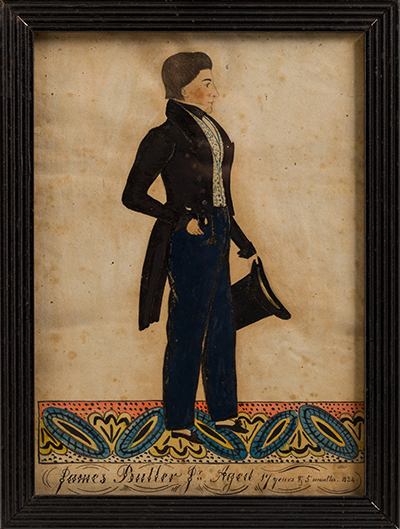
Joseph Davis’s full-length portrait of James Butler Jr, aged 17 years and 5 months, finished at $11,800. Bill Johnson had recorded on the back that he bought the watercolor from the Butler family and had paid $500 for it.
Although the provenance of most of his items is lost, there is a record of his purchase of one item: a Joseph Davis full-length portrait of James Butler Jr with bright colors and in good condition that sold to a phone bidder for $11,800. Johnson had recorded the details of his purchase on the back of the painting. He bought it in Berwick, Maine, from a descendant of the Butler family in 2001. He recorded that he paid $500 for it, and $6,000 for the contents of the house.
Other folk art also did well. A Twentieth Century carved and painted game bird perched on a fanciful rock ended up at $4,130. Two large colorful hooked rugs sold well. One rug depicting a huge lion in the jungle with bright colors made $1,180, and an imaginative rug with a house and barn, along with birds, cats, a horse, an elephant and other animals, made $2,124. A Nineteenth Century wrought iron rooster weathervane seemed like a good buy at $708.
Bill Johnson liked clocks, and there were several in the sale. Leading the category was a Walter Durfee tubular bell chime tall clock, made in Providence, R.I., circa 1885. It had nine nickel-plated tubular bells, Westminster or eight-bells chimes and brass cased weights. Well marked Walter Durfee & Co., it finished at $11,800. An Eighteenth Century tall case clock with a coffin-shaped case, made by P. Rogers & Son, Berwick, Maine, earned $3,540.
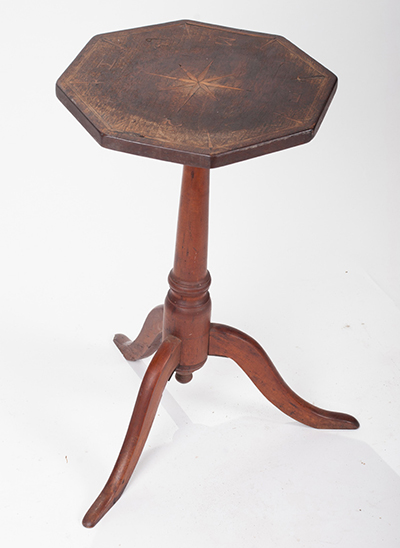
This Eighteenth Century stand had an inlaid top with a compass rose decoration. There were faint dates of 1729 and 1739, along with the initials E. & M.H. It brought $5,310.
Several pieces of American furniture were included in the sale. Some were bargains, and one interesting maple stand inlaid with a compass rose sold for $5,310, well over its estimate of $1,000. It had faint dates of 1729 and 1739 and the initials E. & M.H. Johnson was not overly fussy about the condition of his things and this kept prices down on some of them, especially furniture. Jo Johnson acknowledged that not everything was pristine. She said, “If it had a ding, Bill always said just turn the ding to the wall.”
A transitional Queen Anne side chair, refinished with ended-out rear legs brought only $384, and a North Shore, Mass., Chippendale serpentine front desk with replaced brass and a repaired rear foot went for $1,534.
Johnson also liked mechanical banks, still banks and toys. In some cases, condition kept the prices low. For example, a Dentist mechanical bank with paint loss brought $708, whereas a near mint example sold at a Dan Morphy auction for $9,500. The Boy Scout Camp, cataloged as “badly rusted,” went for $206. Near mint examples of this bank have brought more than $20,000.
Other toys did better. A Steelcraft circa 1930 pedal car with minor paint loss ended up at $2,040, going to an Internet bidder. A McLoughlin set of picture cubes in good condition brought $230, and an early mohair teddy bear, cataloged as “probably Steiff” finished at $3,245. A key-wind six-car set of Marklin trains, with some missing parts and crude repairs, fetched $2,242 from an advanced collector in the room, who said that he was very pleased with the purchase.
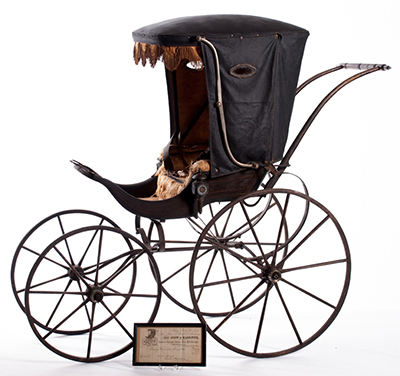
Note the miniature lamps on this Victorian baby carriage. Sold with its original receipt showing an 1875 price of $37.25, its final price at auction was $1,003.
An exceptional Victorian baby carriage with a canopy and a pair of miniature coach lamps came with its original receipt showing that it had cost $37.25 in 1875. The price 140 years was $1,003, selling in the room to Royal Feltner, who has written about early automobiles and carriages. He told Antiques and The Arts Weekly that Amesbury was the carriage-making capital of the United States, with dozens of manufacturers.
The sale included Native American material, and beaded items did well. The most sought-after object was a Nineteenth Century beaded hide coat with a fringe. It was in good condition, with only very minor bead loss. Estimated at $1,500, it went out for $15,340. A 63-inch beaded belt fetched $1,888, and a child’s pair of beaded moccasins achieved $590. A leather-wrapped war club, labeled “War Club of Chief Rain-in-Face, S. Dakota, 1884” was bid to $472.
Also doing well was a 1909 Tiffany Studios bronze counterweight desk lamp with a 7-inch watermelon shade. Its final price was $6,490. A Bradley and Hubbard table lamp with glass “nuggets” set in a brass shade finished at $2,242. An attractive leaded glass window, 19 by 64 inches, with a coastal landscape and evergreens, sold for $2,950.
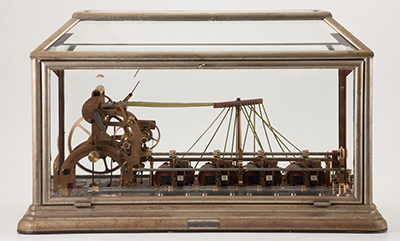
A small Gamewell Fire Telegraph Alarm Co. automatic repeater was offered and fetched $2,360. The devices came in all sizes, depending on the size of the city where they were being used.
Johnson’s interests were wide, so it is not a surprise that the sale included a number of unusual items. One such item was a circa 1880 repeater alarm system made by the Gamewell Fire Telegraph Alarm Co. of New York. Gamewell was the leader in fire alarm systems for towns and cities throughout the United States. This type of repeater was used to send signals from a central station to local fire houses. It was bought by Kinzle, who said that repeaters came in all sizes, depending on the size of the city where it was installed. This repeater brought $2,360.
A brass fireman’s trumpet from Newburyport, Mass., sold to Newbury dealer Paul DeCoste for $826. A wrought iron double-toggle whaling harpoon finished at $2,360, and a carved Fijian Ula throwing club made $1,460. A “sticking tommy” expandable candleholder earned $1,092, and a very long pair of mounted Texas longhorns, 77 inches wide, made $413. McInnis suggested to the crowd that the set of horns should be mounted on the front of a pickup truck.
Perhaps the best buy of the two-day sale was a floor model Belgian coin-operated Barrel Orchestrion music box made by Fr. Mondelaers Leopoldsburg. Paneled and carved oak, with a reverse painted oval above beveled glass mirrors, it was an impressive 90 by 52 by 28½ inches. Its mechanism was in need of adjustment, so it fetched only $1,180.
All prices reported include the buyers’ premium.
For additional information, www.mcinnisauctions.com or 800-822-1417.

